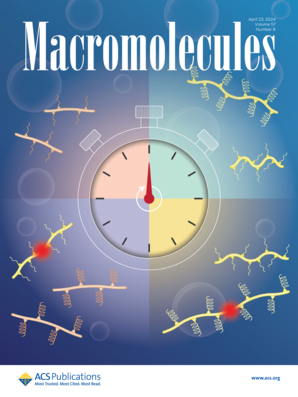利用大尺度分子动力学模拟拉伸非均匀凝胶网络的蝴蝶图案
IF 5.2
1区 化学
Q1 POLYMER SCIENCE
引用次数: 0
摘要
对非均匀凝胶网络进行了大规模的粗粒度分子动力学模拟,以研究二维散射模式中的异常蝴蝶图案。该网络是基于菱形晶格的,在交联点之间的珠子数量分布。值得注意的是,结果证实了异常蝴蝶图案源于更强的不均匀性。对于所检测的系统,正常蝴蝶图案的散射波矢量q的范围与异常蝴蝶图案的散射波矢量q的范围明显不同。这些发现解决了理论预测和实验观察之间差异的一个重要方面。我们还证实了异常蝴蝶图案的峰值位置qx*和强度分别随着拉伸比λ的增大而减小和增大。随着非均匀性的增加,在qx*与λ呈线性关系的区域,λ的下阈值减小,峰强度增大。这种分析异常蝴蝶图案的方法使我们能够研究不同随机交联条件下凝胶网络网络性质的差异。本文章由计算机程序翻译,如有差异,请以英文原文为准。

Butterfly Patterns for Stretched Inhomogeneous Gel Networks Using Large-Scale Molecular Dynamics Simulations
Large-scale coarse-grained molecular dynamics simulations of inhomogeneous gel networks were performed to investigate abnormal butterfly patterns in 2D scattering patterns. The networks were diamond lattice-based with distributions in the number of beads between the cross-link points. Remarkably, the results confirm that the abnormal butterfly pattern originates from a stronger inhomogeneity. For the examined systems, the range of scattering wavevector q for the normal butterfly pattern was markedly different from those for the abnormal butterfly patterns. The findings address an essential aspect of the discrepancy between the theoretical prediction and experimental observations. We also confirmed that the peak position qx* and intensity of the abnormal butterfly pattern decreases and increases, respectively, with increasing stretching ratio λ. As increasing inhomogeneity, it was found that the lower threshold of λ for the region where qx* and λ have a linear relationship decreased and the peak intensity increased. This analytical approach to the abnormal butterfly pattern allows us to study the difference in network properties of gel networks for different random cross-linking conditions.
求助全文
通过发布文献求助,成功后即可免费获取论文全文。
去求助
来源期刊

Macromolecules
工程技术-高分子科学
CiteScore
9.30
自引率
16.40%
发文量
942
审稿时长
2 months
期刊介绍:
Macromolecules publishes original, fundamental, and impactful research on all aspects of polymer science. Topics of interest include synthesis (e.g., controlled polymerizations, polymerization catalysis, post polymerization modification, new monomer structures and polymer architectures, and polymerization mechanisms/kinetics analysis); phase behavior, thermodynamics, dynamic, and ordering/disordering phenomena (e.g., self-assembly, gelation, crystallization, solution/melt/solid-state characteristics); structure and properties (e.g., mechanical and rheological properties, surface/interfacial characteristics, electronic and transport properties); new state of the art characterization (e.g., spectroscopy, scattering, microscopy, rheology), simulation (e.g., Monte Carlo, molecular dynamics, multi-scale/coarse-grained modeling), and theoretical methods. Renewable/sustainable polymers, polymer networks, responsive polymers, electro-, magneto- and opto-active macromolecules, inorganic polymers, charge-transporting polymers (ion-containing, semiconducting, and conducting), nanostructured polymers, and polymer composites are also of interest. Typical papers published in Macromolecules showcase important and innovative concepts, experimental methods/observations, and theoretical/computational approaches that demonstrate a fundamental advance in the understanding of polymers.
 求助内容:
求助内容: 应助结果提醒方式:
应助结果提醒方式:


